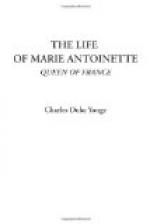It may be added that it is only from the letters of this later period that any quotations are made in the following work; and the greater part of the letters so cited exists in the archives at Vienna, while the others, such as those, addressed by the Queen, to Madame de Polignac, etc., are just such as were sure to be preserved as relics by the families of those to whom they were addressed, and can therefore hardly be considered as liable to the slightest suspicion.
CHAPTER I.
[1] Sainte-Beuve, “Nouveaux Lundis,” August 8th, 1864.
CHAPTER II.
[1] “Histoire de Marie Antoinette,” par E. and J. de Goncourt, p. 11.
[2] How popular masked halls were in London at this time may be learned from Walpole’s “Letters,” and especially from a passage in which he gives an account of one given by “sixteen or eighteen young Lords” just two months before this ball at Vienna.—Walpole to Mann, dated February 27th, 1770. Some one a few years later described the French nation as half tiger and half monkey; and it is a singular coincidence that Walpole’s comment on this masquerading fashion should be, “It is very lucky, seeing how much of the tiger enters into the human composition, that there should be a good dose of the monkey too.”
[3] “Memoires concernant Marie Antoinette,” par Joseph Weber (her foster-brother), i., p. 6.
[4] “Goethe’s Biography,” p. 287.
[5] “Memoires de Bachaumont,” January 30th, 1770.
[6] La maison du roi.
[7] Chevalier d’honneur. We have no corresponding office at the English court.
[8] The king said, “Vous etiez deja de la famille, car votre mere a l’ame de Louis le Grand.”—SAINTE-BEUVE, Nouveaux Lundis, viii., p. 322.
[9] In the language of the French heralds, the title princes of the royal family was confined to the children or grandchildren of the reigning sovereign. His nephews and cousins were only princes of the blood.
CHAPTER III.
[1] The word is Maria Teresa’s own; “anti-francais” occurring in more than one of her letters.




